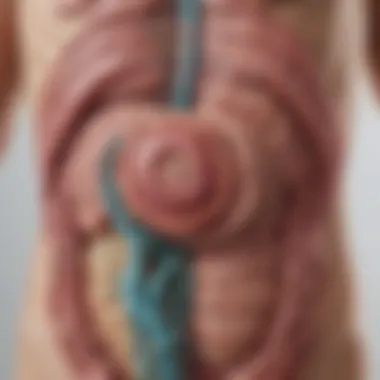IVIG Therapy for Gastroparesis: A Comprehensive Review


Intro
The exploration of intravenous immunoglobulin (IVIG) therapy for patients dealing with gastroparesis opens a fascinating avenue of medical inquiry. Gastroparesis is a complex gastrointestinal disorder marked by delayed gastric emptying. While traditional treatments often center around dietary adjustments and pharmacological agents, the potential role of IVIG invites discussion amongst healthcare professionals and researchers alike. This article aims to shed light on the application of IVIG therapy, delving into the nuances of its rationale and clinical implications.
Key Findings
Major Results
Recent studies have indicated notable successes when using IVIG for treating gastroparesis. Patients have reported significant improvements in symptoms like nausea and abdominal fullness. What’s compelling is the observation that these benefits greatly outshine those typically seen from conventional treatments.
- Symptom Relief: A considerable percentage of patients experienced relief from nausea and improve gastrointestinal functioning.
- Quality of Life: Enhancements in overall well-being and daily functioning have also been observed, indicating that this treatment may extend beyond mere symptom management.
Discussion of Findings
The implications of these findings are profound. IVIG works to modify the immune response, which can be instrumental for patients whose gastroparesis is linked to autoimmune conditions. The connection between immune function and gastrointestinal motility is becoming increasingly recognized in the medical community.
"The ability of IVIG to bolster immune function provides a broader perspective on treating not just symptoms but the underlying conditions affecting gastroparesis."
— Medical Journal of Gastroenterology
Methodology
Research Design
The body of research surrounding IVIG therapy for gastroparesis predominantly employs a prospective cohort design. This approach allows researchers to follow patients receiving IVIG and monitor changes over time, providing invaluable insights into its effectiveness.
Data Collection Methods
Data on patient responses were primarily gathered through:
- Patient Surveys: Pre- and post-treatment surveys capturing symptom severity and overall satisfaction.
- Clinical Assessments: Regular evaluations by healthcare professionals assessing gastric emptying rates and other related metrics.
Engagement from multiple stakeholders, including physicians, nurses and patients, ensures a comprehensive understanding of treatment outcomes. This multilateral approach not only enriches the data but also enhances the treatment experience by considering the views of all involved.
By tackling the complexities of IVIG usage for gastroparesis, this article seeks to provide a well-rounded perspective for students, researchers, educators, and professionals in the field. Through an intricate dance of immune modulation and gastrointestinal recovery, IVIG could represent a breakthrough in managing this challenging condition.
Understanding Gastroparesis
Gastroparesis is a condition that many may not fully grasp, but it plays a crucial role in the lives of those affected. Understanding this disorder is key to exploring treatment options, such as intravenous immunoglobulin (IVIG) therapy. By delving into the problem, we can comprehend the challenges patients face, better appreciate the need for effective interventions, and understand how the therapy can help.
Definition and Overview
Gastroparesis, simply put, is a condition in which the stomach cannot properly empty its contents. This leads to a variety of symptoms such as nausea, vomiting, bloating, and abdominal pain. For those living with this disorder, each meal can feel like a battle. The delay in gastric emptying affects not just digestion, but overall quality of life.
Pathophysiology of Gastroparesis
Understanding the pathophysiology behind gastroparesis is essential for targeting treatments effectively. This involves detailing how various factors influence the condition.
Neurological Factors
Neurological factors play a big role in gastroparesis, influencing the nervous system's ability to communicate with the stomach. Issues with nerves, particularly the vagus nerve, can lead to impaired gastric motility. This nerve is essentially the messenger, sending signals that stimulate stomach muscles to contract and move food along. If these signals are disrupted, it can create a domino effect leading to severe gastrointestinal distress. Neurological involvement is critical to understanding various treatment modalities, as addressing nerve dysfunction can sometimes alleviate symptoms.
Muscular Dysfunction
Muscular dysfunction refers to the issue of the stomach muscles themselves failing to contract properly. For example, weakened muscles may not have the strength to push food through the digestive tract efficiently. This aspect is particularly concerning as it means that even when the nerves are functioning correctly, the mechanical aspect of digestion can still fail. Acknowledging muscular dysfunction is vital because it helps frame potential intervention strategies that might include muscle stimulants or dietary modifications that reduce the workload on the gastrointestinal tract.
Gastrointestinal Motility
Lastly, gastrointestinal motility is the broader term that encompasses how food moves through the digestive system. Disrupted motility in the stomach can lead to extended processing times and various complications related to digesting meals. The key characteristic of gastrointestinal motility is that it relies on a harmonious function of nerves, muscles, and hormones. If any part of this system falters, symptoms can worsen, highlighting the need for targeted therapies and a comprehensive understanding to inform treatment plans.
Epidemiology and Prevalence


Gastroparesis impacts a surprisingly large segment of the population, with estimates suggesting that around 1 in 1000 individuals in the United States are affected. However, understanding the full prevalence means recognizing the hidden nature of the disorder; many people may go undiagnosed due to its overlap with other gastrointestinal disorders. Factors such as diabetes, surgery, and certain medications can increase risk rates, which makes awareness and education on the topic all the more essential. Understanding epidemiology not only sheds light on the scope of gastroparesis but also underscores the imperative for ongoing research and patient support.
Current Treatment Approaches
In the realm of managing gastroparesis, the need for diverse treatment options can't be overstated. This condition, characterized by the stomach's sluggish emptying, often leaves patients grappling with nausea, bloating, and discomfort. Thus, recognizing and implementing the appropriate treatment approaches is crucial, as it can significantly impact symptom management and overall quality of life. Here, we delve deep into the common strategies employed, focusing on dietary adjustments, pharmacological interventions, and, when necessary, surgical solutions. Each of these methods plays a role in alleviating symptoms and improving patient functionality.
Dietary Modifications
Dietary modifications are often the first line of defense for those with gastroparesis. Adopting a meal plan that considers the unique needs of the gastrointestinal system can be pivotal. Essentially, patients are urged to pivot towards smaller, more frequent meals rather than the traditional three-square meals. This helps the stomach manage its workload more effectively.
- Types of food: Certain foods are easier to digest for individuals with gastroparesis. Low-fiber and low-fat diets often yield better results. Think soft-cooked vegetables, easy-to-digest grains like white rice, and tender meats.
- Hydration is key: Keeping hydrated is equally important, but fluids should ideally be consumed between meals to avoid feeling overly full.
- Nutritional supplements: In some cases, nutritional supplements can help patients meet their dietary needs without overwhelming their systems. These may include high-protein, low-fat shakes.
Medications
Pharmacological interventions play a substantial role in the management of gastroparesis symptoms. There are primarily two categories of drugs used: prokinetic agents and antiemetics. Each type serves a distinct purpose and can lead to varying degrees of symptom relief.
Prokinetic Agents
Prokinetic agents are designed to enhance gastrointestinal motility. They work by stimulating the muscles in the stomach, promoting quicker emptying of gastric contents.
- Key highlighted characteristic: One of the standout features of prokinetic agents is their ability to increase gastric contractions. Medications like metoclopramide are popular choices in this category.
- Benefits: They can be particularly effective for those experiencing severe symptoms, providing a noticeable reduction in nausea and improving overall gastric emptying times.
- Drawbacks: However, potential side effects can include fatigue, anxiety, or even movement disorders in some individuals, which is a critical factor for clinicians to consider.
Antiemetic Drugs
Antiemetic drugs come into play primarily when nausea and vomiting are significant issues. These medications can serve to ease the emotional and physical discomfort that accompanies gastroparesis.
- Key characteristic: Antiemetics, such as ondansetron, block the signals in the brain that trigger nausea. Their efficacy makes them a valuable option in the treatment arsenal.
- Advantages: They are often well-tolerated and can provide quick relief from acute episodes of nausea, helping patients regain a sense of normalcy.
- Disadvantages: One should be cautious, however, as over-reliance might mask underlying issues without addressing the root cause of gastric slow-down.
Surgical Interventions
When all else fails, surgical interventions may be deemed necessary. These approaches, while more invasive, can provide relief that non-invasive methods cannot achieve.
- Gastric electrical stimulation: This innovative technique involves implanting a device to stimulate the stomach muscles, helping them contract stronger and more effectively.
- Surgery for gastroparesis: In extreme cases, a partial gastrectomy might be performed, which involves removing a section of the stomach to improve emptying, although this is a rare solution.
Intravenous Immunoglobulin (IVIG) Therapy
Intravenous immunoglobulin (IVIG) therapy has emerged as a noteworthy intervention in the realm of treating gastroparesis. This treatment, primarily known for its role in managing autoimmune conditions and immunodeficiencies, has shown promising potential in alleviating the symptoms associated with gastroparesis. As healthcare professionals strive to find effective means to address this debilitating gastrointestinal disorder, understanding the specifics of IVIG therapy becomes critical. Key highlights of this therapy include its mechanisms, indications for use, and dosage adaptation tailored to individual patient needs.
Mechanism of Action
IVIG functions through several intricate pathways that modulate the immune response. Primarily, it consists of a pooled preparation of immunoglobulins derived from healthy donors' blood. This means each dose contains various antibodies that can influence different immune processes. One of the major functions of IVIG is its ability to neutralize harmful autoantibodies, which may play a role in diseases like gastroparesis. These autoantibodies can disrupt normal motility in the gastrointestinal tract, leading to the symptoms often witnessed by patients.
Moreover, IVIG is thought to enhance the efficacy of the immune system by stimulating the production of cytokines, which are crucial in cell signaling. The infusion of IVIG can ultimately lead to improved gastrointestinal motility and symptom relief, as the treatment aims to restore balance in the immune system.
Indications for Use
The use of IVIG in gastroparesis may not be as widely established when compared to other therapies, but it is gaining traction due to its unique approach. The following situations may warrant consideration for IVIG therapy in gastroparesis patients:
- Autoimmune Disorders: Patients diagnosed with autoimmune conditions like lupus or scleroderma, where gut involvement could manifest as gastroparesis.
- Dysautonomia: Those with autonomic nervous system dysfunction benefitting from the modulating effects of IVIG.
- Post-Infectious Gastroparesis: Gastrointestinal anomalies following a viral or bacterial infection might respond well to this therapy.
- Idiopathic Gastroparesis: Cases where the underlying cause is not yet understood could potentially benefit from the immune modulation provided by IVIG.
It's critical for clinicians to evaluate each patient individually, considering the broader landscape of their medical history and symptoms to determine the appropriateness of IVIG treatment.
Dosage and Administration
Administering IVIG must be carefully structured to maximize efficacy while minimizing potential side effects. Typical dosing guidelines recommend:
- Initial Dosing: An infusion rate usually starts at a lower level to gauge patient response, potentially around 0.5 grams per kilogram of body weight.
- Maintenance Dosing: This might be adjusted depending on individual tolerability and clinical responses, with common regimens ranges usually falling between 1 to 2 grams per kilogram every 3 to 4 weeks.
- Administration Setting: Administered via intravenous infusion, healthcare providers need to monitor for any adverse reactions during the first few doses. This includes assessing for signs of infusion-related reactions, such as fever, chills, or headache.
In orchestrating the treatment plan, practitioners should ensure that the delivery of IVIG is tailored to both the patient's needs and clinical judgment. Frequent follow-ups are important to assess the treatment's sustained effectiveness and any need for dosage adjustments.


In summary, IVIG therapy represents a forward-thinking strategy in tackling gastroparesis. With expectations tied to its unique mechanisms and indications, this therapy may pave the way for improved management of this complex and challenging disorder.
Clinical Evidence on IVIG for Gastroparesis
The exploration of clinical evidence regarding the use of IVIG for treating gastroparesis is essential to unravel the layers of complexity surrounding this approach. As more patients seek varied treatment options, it becomes crucial to highlight the emerging data that suggest IVIG may offer benefits for patients who suffer from this condition. Not only does this section lay out the foundation for understanding the effectiveness of this therapy through tangible examples, but it also examines the landscape of ongoing clinical research, ultimately aiming to deliver a clear picture of its clinical relevance.
Case Studies
Case studies serve as crucial reference points in understanding how IVIG might help those with gastroparesis. By examining individual cases, we can glean not only the potential benefits but also the variances in patient response to treatment.
One notable case involved a patient previously unresponsive to conventional therapies such as prokinetic agents. Upon administration of IVIG, this individual reported significant reduction in nausea and improved gastric emptying. Observations from such unique cases illuminate the nuances of the treatment’s effectiveness, establishing a narrative of possibility amidst the challenges of gastroparesis.
Clinical Trials
In addition to case studies, clinical trials play a pivotal role in substantiating the viability of IVIG as a therapeutic option. Several trials have investigated different dosages and delivery methods of IVIG in patients diagnosed with gastroparesis.
A systematic review of these trials revealed a trend where patients receiving IVIG showed improved gastrointestinal motility compared to those on standard treatment alone. The statistical data emerging from these trials lends credence to IVIG’s role, suggesting it could be a game changer for specific patient demographics.
Efficacy and Outcomes
Symptom Improvement
Focusing on symptom improvement adds another layer to the analysis of IVIG’s effectiveness. With gastroparesis, patients often battle a constellation of symptoms, including persistent vomiting, early satiety, and abdominal pain. One of the most compelling attributes of IVIG therapy is its potential to significantly ease these debilitating symptoms, allowing patients to reclaim aspects of normal life.
In many instances, the reported improvement in symptoms not only contributes to enhanced physical comfort but also serves as a testament to the treatment's acceptance. Although initial responses can vary, the cumulative data show promising results indicating that symptom relief can often lead to more stable management of gastroparesis. This aspect is pivotal since patients often feel frustrated by the limited options available, making symptom relief incredibly valuable.
Quality of Life Assessments
Quality of life assessments are another critical angle from which to evaluate the impact of IVIG treatment. These assessments delve into how a therapeutic intervention influences not only physical health but psychological well-being.
In the context of IVIG for gastroparesis, studies have revealed that patients experienced marked improvement in daily functioning and emotional wellbeing. For many, regaining the ability to eat comfortably and participate in social activities can markedly change one’s outlook. The interrelation between physical symptomatology and emotional health cannot be overstated; thus, the enhancement of quality of life underscores the broader implications of using IVIG. This characteristic helps solidify IVIG's role as a valid treatment consideration.
Ultimately, the interplay between symptom improvement and quality of life evaluations provides a rich tapestry of outcomes that further justifies the examination of IVIG therapy for gastroparesis. The insights drawn from these sections reveal an increasing consensus on the possibility of IVIG being a beneficial therapeutic option, while also indicating the necessity for further research to optimize protocols and understand long-term impacts.
Adverse Effects and Considerations
Understanding the adverse effects of IVIG therapy for gastroparesis is crucial for ensuring that both patients and healthcare professionals can make well-informed decisions. While the benefits of this treatment may be promising, it's equally important to be aware of the risks involved. This balance helps in weaving a more comprehensive fabric of patient care, where potential complications do not overshadow the therapeutic effects.
Potential Side Effects of IVIG
IVIG treatment can trigger various side effects, some of which may require prompt attention. Here are some potential adverse effects:
- Headaches: One of the most commonly reported side effects. Many patients experience a dull or throbbing headache after administration.
- Nausea: Some individuals may find themselves feeling unsettled, which can further complicate an already challenging condition like gastroparesis.
- Fatigue: Although many look for an improvement in their energy levels post-treatment, fatigue can become a temporary companion instead.
- Allergic Reactions: While rare, reactions can range from mild rashes to severe anaphylaxis, necessitating immediate medical intervention.
- Renal Dysfunction: Some reports have noted cases where IVIG may impact kidney function, particularly concerning those with pre-existing conditions.
It's essential that patients discuss these possibilities with their healthcare provider before starting treatment.
Contraindications
Diving deeper, it’s pivotal to recognize when IVIG should not be used. Contraindications could potentially steer healthcare providers away from prescribing this treatment in specific scenarios. Key contraindications include:
- History of Thrombosis: Individuals with a prior condition of blood clotting may have heightened risks when receiving IVIG therapy.
- Hypersensitivity to Components: Some patients might exhibit a known allergy to immunoglobulin preparations, prompting careful consideration or alternative options.
- Immunoglobulin-Related Conditions: Patients who face certain autoimmune conditions must evaluate the risks and benefits meticulously.
Understanding these contraindications helps in shaping a safer treatment plan, ensuring that IVIG is offered only when beneficial.
Monitoring and Follow-Up
After initiating therapy, monitoring and follow-up become vital components in the patient's journey. Ongoing evaluations allow clinicians to catch any adverse effects early and provide immediate interventions if necessary. Critical aspects to consider include:
- Vital Signs: Routine checks of blood pressure, heart rate, and temperature to identify any anomalies that may signal complications.
- Laboratory Tests: Regular blood tests to assess liver and kidney function can help catch problems before they escalate.
- Symptom Tracking: Patients should maintain a diary detailing any side effects or changes in symptoms. Noting down when and how these occur can be invaluable for follow-up consultations.


"Regular monitoring not only safeguards the patient's well-being but enhances the overall efficacy of IVIG treatment."
Role of Healthcare Professionals
The role of healthcare professionals in managing gastroparesis and administering IVIG therapy cannot be overstated. These professionals are often at the forefront, navigating the complexities of diagnosis and treatment. Their expertise is crucial in tailoring approaches that are specific to individual patient needs, considering the unique challenges that gastroparesis presents. Successful management hinges on a coordinated effort that encompasses assessment, treatment planning, and ongoing support.
Patient Assessment and Diagnosis
A thorough patient assessment is the cornerstone of effective treatment. Healthcare professionals start with an in-depth history that includes symptoms, dietary habits, and quality of life. Specific tools might be employed, such as motility studies or gastric emptying tests, to confirm a diagnosis of gastroparesis. It’s essential to consider the symptoms that extend beyond basic gastrointestinal discomfort, like nausea, bloating, or early satiety.
The interpretation of survey responses and lab results requires clinical acumen. Quite often, gastroparesis coexists with other disorders, necessitating a comprehensive understanding of each patient’s overall health profile. This layered approach allows professionals to identify specific factors worsening the condition, ensuring patients receive the most appropriate interventions.
Developing a Treatment Plan
Once a diagnosis is established, developing a well-rounded treatment plan is vital. This process often draws from a variety of therapeutic modalities. Healthcare professionals will consider dietary changes, medications, and possibly IVIG therapy. Each aspect should align with the patient’s specific symptoms and preferences.
A good treatment plan should not only target symptom relief but also enhance the patient’s functional capacity and quality of life. Regular follow-ups and adjustments to the plan are critical, as reactions to treatment can vary significantly from one individual to another. For example, some patients may respond well to prokinetic agents, while others might experience enhanced relief from IVIG. Setting achievable goals and discussing potential outcomes gives patients a clearer roadmap while fostering a sense of partnership in their care.
Interdisciplinary Collaboration
The management of gastroparesis often requires collaboration across multiple healthcare disciplines. Professionals from various fields, such as gastroenterology, nutrition, and pharmacy, come together, each bringing a unique perspective and expertise. Such interdisciplinary approaches can provide a more holistic care experience.
Involvement of dieticians, for instance, helps tailor meal plans that accommodate gastroparesis symptoms while ensuring nutritional needs are met. Also, pharmacists play a crucial role by advising on medication interactions and ensuring that treatments like IVIG are administered properly and monitored closely for effectiveness.
Ultimately, this collaborative dynamic is essential for guiding patients through their healthcare journey. It encourages communication among professionals and between the patient and the team, ensuring that care is coordinated and cohesive.
"An interdisciplinary approach not only enriches the treatment plan but fosters a supportive community around the patient, enhancing their overall experience and outcomes."
Future Directions in Gastroparesis Treatment
The field of gastroparesis treatment is ever-evolving, reflecting the unique challenges posed by this condition. As research paves the way, the future directions in managing gastroparesis carry significant weight. More than just a clinical need, these advancements denote hope for improved patient outcomes. A multifaceted approach, including new therapeutics, enhanced monitoring techniques, and personalized medicine strategies, is crucial for advancing patient care and understanding in this domain.
Research on New Therapeutics
The landscape of treatment for gastroparesis can be revolutionized by ongoing research into novel therapeutic agents. Various studies seek to uncover new medications aimed at alleviating the frustrating symptoms faced by individuals living with gastroparesis. For instance, agents that modulate gastrointestinal motility or impact the immune response are currently under investigation.
- Potential candidates for therapeutic development include:
- New prokinetic agents that may enhance gastric emptying more effectively than available options.
- Immunomodulatory drugs targeting the underlying pathophysiological mechanisms of gastroparesis.
Furthermore, earlier identification of gastroparesis subtypes may lead to the development of tailored drugs that fit specific patient needs. Keeping an eye on breakthroughs in this area can certainly help redefine treatment protocols, emphasizing the necessity for practitioners to stay updated with the latest findings.
Advancements in Monitoring Techniques
As gastroparesis presents varied symptoms, effective monitoring of the condition is paramount. Recent technological strides hold the potential to vastly improve how clinicians track disease progression and treatment efficacy. One such advancement lies in gastric electrical activity monitoring, employing devices that patients can wear at home.
- Key advancements include:
- Wearable devices that gather real-time data, providing insights into gastric emptying and symptom patterns.
- Gastric imaging techniques, helping to visualize the dynamics of gastric motility and allowing clinicians to make informed adjustments to treatment regimens.
These innovations not only foster a more engaged patient experience but also equip healthcare providers with critical information, enabling a shift from reactive to proactive management of gastroparesis.
Personalized Medicine Approaches
The concept of personalized medicine heralds a new era in gastroparesis treatment, aiming to address individual variations in disease presentation and response to therapy. The focus shifts from a one-size-fits-all strategy to a more tailored approach, taking genetic, environmental, and lifestyle factors into account.
- Incorporating personalized medicine may involve:
- Utilizing genetic testing to discern individual responses to certain medications.
- Adjusting dietary recommendations based on unique patient needs and preferences.
This shift is crucial, as it aligns treatment with the distinct characteristics of each patient. By harnessing the power of genomic and microbiome research, the future could see therapies that are finely tuned to the specific biochemistry of each individual, offering the hope of significant improvement in quality of life for patients.
"A tailored approach not only enhances the therapeutic benefit but also improves patient adherence to treatment plans."
Embracing these future directions in gastroparesis treatment is not merely an aspiration; it’s a necessity. By harnessing the power of ongoing research and technological advancements, healthcare professionals can not only address current gaps in treatment but also usher in a new standard of care that truly caters to the needs of patients.



